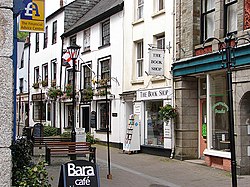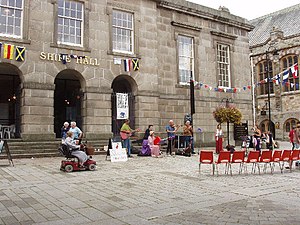Bodmin
| Bodmin Cornish: Bosvenegh | |
| Cornwall | |
|---|---|
 Honey Street, Bodmin | |
| Location | |
| Grid reference: | SX071665 |
| Location: | 50°27’59"N, 4°43’4"W |
| Data | |
| Population: | 12,778 (2001) |
| Post town: | Bodmin |
| Postcode: | PL31 |
| Dialling code: | 01208 |
| Local Government | |
| Council: | Cornwall |
| Parliamentary constituency: |
North Cornwall |
Bodmin is a major town in Cornwall found in the centre of the county southwest of Bodmin Moor. Bodmin, the county town of Cornwall, was the centre of its judicial administration after 1835 when the courts moved to from Launceston, until the main courts moved again, to Truro.
Bodmin lies in the centre of Cornwall, south-west of the granite massif of Bodmin Moor. It is an ancient town, first built on monasticism and later made wealthy from tin mining and the attentions of the Duchy of Cornwall.
The origin of the town's name has been the subject of debate. It has been suggested that the town's name comes from an archaic word in the Cornish language; bod (a dwelling; the later word is bos) and menegh ("monks"). It may refer to a monastic settlement founded by St Petroc or to an earlier settlement of St Guron, which St Petroc took as his site. Guron is said to have departed to St Goran on the arrival of Petroc.
Contents
History
Saint Petroc founded a monastery in Bodmin in the sixth century[1] and gave the town its alternative name of Petrockstow. The monastery was deprived of some of its lands at the Norman Conquest but at the time of Domesday still held 18 manors, including Bodmin, Padstow and Rialton.[2] Bodmin is one of the oldest towns in Cornwall, and the only large Cornish settlement recorded in the Domesday Book of 1086. In the fifteenth century the Norman church of St Petroc was largely rebuilt and stands as one of the largest churches in Cornwall (the largest after the cathedral at Truro). Also built at that time was an abbey of canons regular, now mostly ruined. For most of Bodmin's history, the tin industry was a mainstay of the economy.
An inscription on a stone built into the wall of a summer house in Lancarffe furnishes proof of a settlement in Bodmin in the early Middle Ages. It is a memorial to one "Duno[.]atus son of Me[.]cagnus" and has been dated from the sixth to eighth centuries.[3]
The Black Death killed half of Bodmin's population in the mid fourteenth century (1500 people).[4]
Rebellions
Bodmin was the centre of three Cornish uprisings. The first was the Cornish Rebellion of 1497 in the reign of Henry VII when a Cornish band led by Michael An Gof, a blacksmith from St Keverne, and Thomas Flamank, a lawyer from Bodmin, marched to Blackheath in London where they were eventually defeated by 10,000 men of the King's army. In the Autumn of 1497, Yorkists declared Perkin Warbeck to be the missing Prince Richard of York and tried to overthrow King Henry; Warbeck was proclaimed King Richard IV in Bodmin but the King had little difficulty crushing the uprising.
Finally, in 1549, Cornishmen rose once again in the Prayer Book Rebellion when the staunchly Protestant King Edward VI imposed a new Book of Common Prayer. Cornishmen still attached to the Roman Catholic formed an army in Bodmin and marched across the border to lay siege to Exeter in Devon. Proposals to translate the Prayer Book into Cornish were suppressed and in total 4,000 people were killed in the rebellion.[5] In later years, it was Cornwall which became the most staunchly Protestant land.
Churches
Parish church of St Petroc
The existing church building is dated 1469-72 and was until the building of Truro Cathedral the largest church in Cornwall. The tower which remains from the original Norman church and stands on the north side of the church (the upper part is fifteenth century) was, until the loss of its spire in 1699, 150 ft high. The building underwent two Victorian restorations and another in 1930. It is now listed Grade I.
There are a number of interesting monuments, most notably that of Prior Vivian which was formerly in the Priory Church (Thomas Vivian's effigy lying on a chest: black Catacleuse stone and grey marble). The font of a type common in Cornwall is of the twelfth century: large and finely carved.[6][7]
The Chapel of St Thomas Becket
The Chapel of St Thomas Becket is a ruin of a fourteenth century building in Bodmin churchyard. The holy well of St Guron is a small stone building at the churchyard gate. The Berry Tower is all that remains of the former church of the Holy Rood and there are even fewer remains from the substantial Franciscan Friary established ca. 1240: a gateway in Fore Street and two pillars elsewhere in the town.
Sites of interest
Bodmin Gaol ran for over 150 years but is now a semi-ruin. It was built in the late eighteenth century, and was the first British prison to hold prisoners in separate cells (though often up to 10 at a time) rather than communally. Over fifty prisoners condemned at the Bodmin Assize Court were hanged at the prison. It was also used for temporarily holding prisoners sentenced to transportation, awaiting transfer to the prison hulks lying in the highest navigable reaches of the River Fowey. Also, during First World War the prison held some of Britain's priceless national treasures including the Domesday Book, the ring and the Crown Jewels of the United Kingdom.
Shire Hall was the centre of county administration, but now serves as a tourist information centre
The Regimental Barracks of the Duke of Cornwall's Light Infantry are now a regimental museum. The museum includes the history of the regiment from 1702 and a military library. The original barracks house the regimental museum and it was founded in 1925. There is a fine collection of small arms and machine guns, plus maps, uniforms and paintings on display.
Bodmin County Lunatic Asylum was designed by John Foulston and afterwards George Wightwick. William Robert Hicks the humorist was domestic superintendent in the mid-nineteenth century. [8][9][10]
Freemasons Hall stands in St Nicholas Street, which is home to no less than seven Masonic bodies (foundation dates in brackets).[11]
- One & All Lodge No. 330 (8 March 1810);
- Beacon Lodge No. 9425 (15 February 1991);
- Saint Petrock Chapter No. 330 (7 November 1877);
- St Nicholas Lodge of Mark Master Masons No. 1188 (1 December 1954);
- St Nicholas Lodge of Royal Ark Mariners No. 1188 (1 February 1979);
- Conclave of Light of the Masonic & Military Order of the Red Cross of Constantine No. 498 (23 April 2009)
- Bodiniel Quarry Assemblage of the Worshipful Society of Free Masons (15 October 1988)
Around the town
The Bodmin Beacon Local Nature Reserve is the hill overlooking the town. The reserve has 83 acres of public land and has at the summit a monument to Sir Walter Raleigh Gilbert[12] built in 1857 by the townspeople of Bodmin to honour the soldier's life and work in India.
Langdon (1896) records six crosses in the parish of which the finest is at Carminow. An ornate granite drinking bowl which serves the needs of thirsty dogs at the entrance to Bodmin's Priory car park was donated by Prince Chula Chakrabongse of Thailand who lived at Tredethy.[13]
Events
On Halgaver Moor (Goats' Moor) near Bodmin there was once an annual carnival in July which was on one occasion attended by King Charles II.[14]
Bodmin Riding is a traditional annual ceremony.
'Beating the bounds' and 'hurling'
In 1865–66 William Robert Hicks was mayor of Bodmin, when he revived the custom of Beating the bounds of the town. He was — according to the Dictionary of National Biography — a very good man of business. This still takes place more or less every five years and concludes with a game of Cornish hurling. Hurling survives as a traditional part of beating the bounds at Bodmin, commencing at the close of the 'Beat'. The game is organised by the Rotary club of Bodmin and was last played in 2010. The game is started by the Mayor of Bodmin by throwing a silver ball into a body of water known as the "Salting Pool". There are no teams and the hurl follows a set route. The aim is to carry the ball from the "Salting Pool" via the old A30, along Callywith Road, then through Castle Street, Church Square and Honey Street to finish at the Turret Clock in Fore Street. The participant carrying the ball when it reaches the turret clock will receive a £10 reward from the mayor.[15] The next occurrence of the Bodmin Hurl will be following the next beating of the bounds, which is unlikely to take place until 2015.
Notes
- ↑ Doble, G. H. (1965) The Saints of Cornwall: part 4. Truro: Dean and Chapter; pp. 132-166
- ↑ Thorn, C et al. (eds.) (1979) Cornwall. Chichester: Phillimore; entries 4,3-4.22
- ↑ Discussion, photo and bibliography in Okasha, Elisabeth (1993). Corpus of early Christian inscribed stones of South-west Britain Leicester: University Press, pp. 126-128
- ↑ "Black Death". http://www.cornwall.gov.uk/index.cfm?articleid=5749. Retrieved 2009-09-17.
- ↑ Sturt, John (1987) Revolt in the West: the Western Rebellion of 1549. Exeter: Devon Books
- ↑ Pevsner, N. (1970) Cornwall; second ed. Penguin Books
- ↑ Sedding, Edmund H. (1909) Norman Architecture in Cornwall: a handbook to old ecclesiastical architecture. London: Ward & Co.; pp. 21-36
- ↑ Bodmin workhouse, later St Lawrence's Hospital (Illustration) (Peter Higginbotham's Workhouse website - accessed 16 Oct 2007)
- ↑ Middlesex University index of County Asylums. Accessed 16 Oct 2007
- ↑ History of St Lawrence's Hospital, after its closure. Accessed 29 November 2007
- ↑ Cornwall Masonic Yearbook 2009/10
- ↑ Chichester, H. M. (2004) 'Gilbert, Sir Walter Raleigh, first baronet (1785–1853)', rev. Roger T. Stearn, Oxford Dictionary of National Biography, Oxford University Press, 2004 accessed 1 Jan 2008
- ↑ "New Zealand Cornish Association newsletter". http://www.busby.net/nzca/NZCA_NLvol380Jan09.pdf. Retrieved 2009-05-24.
- ↑ Brewer's Dictionary of Phrase and Fable
- ↑ 2010 Bodmin Hurl Rules, Rotary Club of Bodmin, 02/04/2010.
Further reading
- Henderson, Charles (1935) "Some Notes on Bodmin Priory", in: Essays in Cornish History. Oxford: Clarendon Press; pp. 219–28
Outside links
| ("Wikimedia Commons" has material about Bodmin) |
- North Cornwall District Council. "Bodmin Beacon Nature Reserve". http://www.ncdc.gov.uk/index.cfm?articleid=22251. Retrieved 2009-05-31.
- St Petroc's Primary School. "St Petroc's Primary School". http://www.st-petrocs.cornwall.sch.uk. Retrieved 2009-05-31.
- Bodmin Town Council. "Bodmin Town Council services". http://www.bodmin.gov.uk. Retrieved 2009-05-31.
- "A Brief History of Bodmin". http://www.localhistories.org/bodmin.html. Retrieved 2009-05-31.
- "Bodmin Live". http://www.bodminlive.com. Retrieved 2009-05-31.
- Postcards of Bodmin
